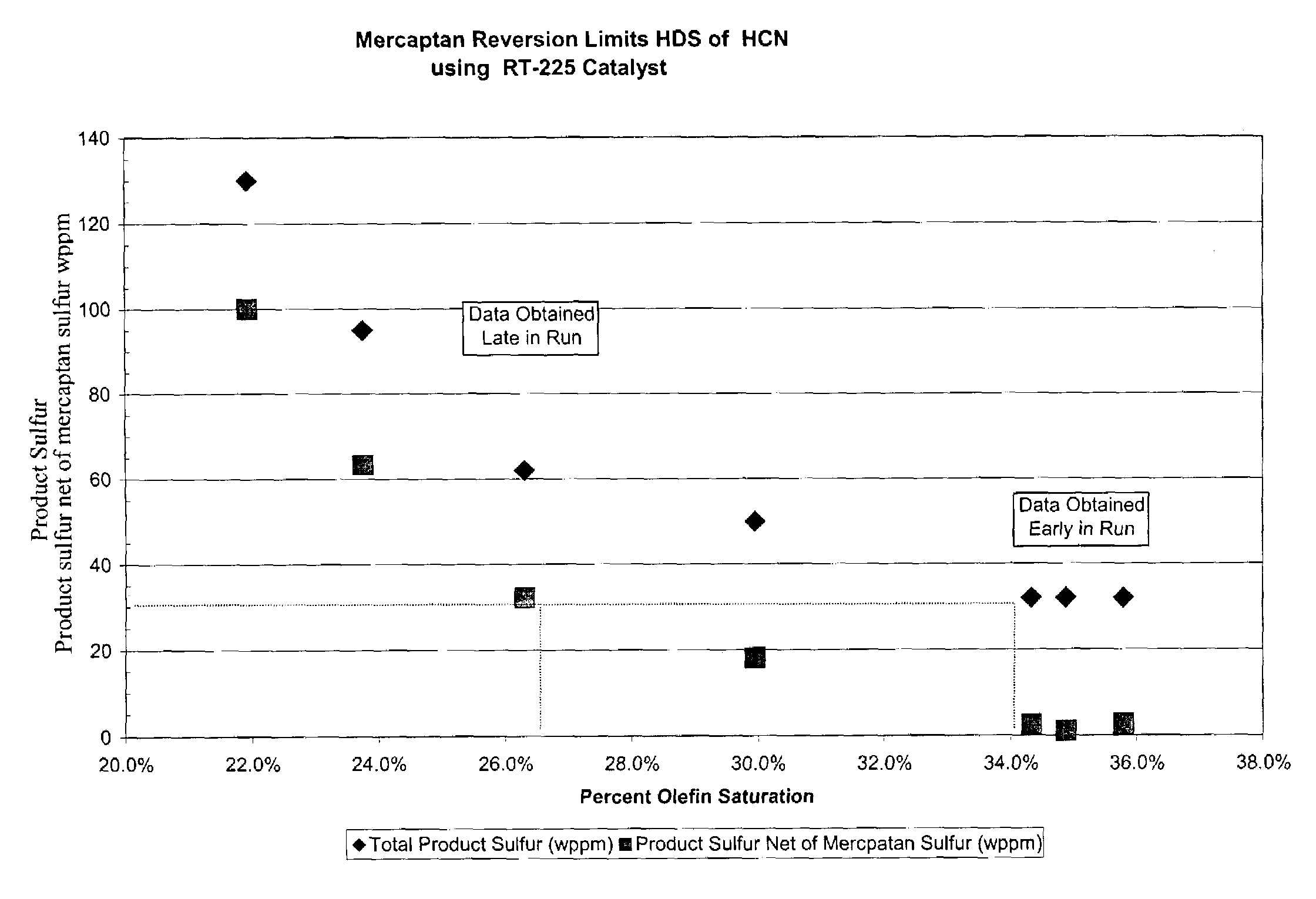Selective hydroprocessing and mercaptan removal
a technology of selective hydroprocessing and mercaptan, which is applied in the direction of refining with aqueous alkaline solutions, fuels, refining to eliminate heteroatoms, etc., can solve the problems of significant octane loss and severe octane loss
- Summary
- Abstract
- Description
- Claims
- Application Information
AI Technical Summary
Benefits of technology
Problems solved by technology
Method used
Image
Examples
example 1
[0065]A sample of naphtha product from a commercial Fluid Catalytic Cracking unit was fractionated to provide an intermediate cat naphtha (ICN) stream having a nominal boiling range of 180-370° F. The ICN stream contained 3340 wppm sulfur and 32.8 vol % olefins (measured by FIA) and had a Bromine number of 50.7. The ICN stream was hydrotreated at SCANfining conditions using RT-225 catalyst at 500° F., 250 psig, 1500 SCF / B hydrogen treat gas and 0.5 LHSV. The SCANfiner product contained 93 wppm sulfur and had a Bromine number of 19.4. Of the 93 wppm sulfur, 66 wppm was mercaptan reversion sulfur and the remainder was non-mercaptan sulfur. The SCANfiner product was sweetened by contacting it in air with a solution of 20 wt % NaOH in water and 500 wppm cetyltrimethylammonium bromide in water. The resulting sweetened SCANfiner product contained 5 wppm mercaptan reversion sulfur. The sweetened SCANfiner product was then fractionated via a 15 / 5 distillation to achieve a 350° F. cut point....
example 2
[0067]A commercially prepared, catalyst (RT-225) consisting of 4.34 wt % MoO3, 1.19 wt % CoO. SCANfining operation was demonstrated using a catalyst in a commercially available 1.3 mm asymmetric quadralobe size with a Heavy Cat Naphtha feed, 2125 wppm total sulfur, and 27.4 bromine number, in an isothermal, downflow, all vapor-phase pilot plant. Catalyst volume loading was 35 cubic centimeters. Reactor conditions were 560° F., 2600 scf / b, 100% hydrogen treat gas and 300 psig total inlet pressure. Due to small random changes that occured while adjusting pump settings, space velocity was varied between 3 and 5 LHSV (defined as volume of feed per volume of catalyst per hour). Overall sulfur removal levels ranged between 93.9 and 98.5% and olefin saturation between 21.9 and 35.8%. FIG. 1, shows product sulfur levels, both total and product sulfur less mercaptan reversion sulfur, as a function of olefin saturation. To make 30 ppm sulfur in the product without mercaptan sulfur removal wou...
example 3
[0068]A commercially prepared, reference batch of KF-742 (10 cc charge) conventional hydrotreating catalyst was used in this test. The catalyst (KF-742) consisted of 15.0 wt % MoO3, 4.0 wt % CoO. The SCANfining operation was demonstrated using a catalyst in a commercially available 1.3 mm asymmetric quadralobe size with a Heavy Cat Naphtha feed, 2125 wppm total sulfur, and 27.4 bromine number in an isothermal, downflow, all vapor-phase pilot plant. Reactor conditions were 560° F., 2600 scf / b, 100% hydrogen treat gas and 300 psig total inlet pressure. For this test, space velocity was adjusted between 7 and 28 LHSV and all of the data was collected near end of run (30 to 38 days on cat naphtha). Each day, a small decrease in feed rate was made. Overall sulfur removal levels ranged between 92.5 and 99.2% and olefin saturation between 21.9 and 35.8%. FIG. 2, shows product sulfur levels, both total and product sulfur less mercaptan reversion sulfur, as a function of olefin saturation. T...
PUM
| Property | Measurement | Unit |
|---|---|---|
| wt. % | aaaaa | aaaaa |
| wt % | aaaaa | aaaaa |
| temperature | aaaaa | aaaaa |
Abstract
Description
Claims
Application Information
 Login to View More
Login to View More - R&D
- Intellectual Property
- Life Sciences
- Materials
- Tech Scout
- Unparalleled Data Quality
- Higher Quality Content
- 60% Fewer Hallucinations
Browse by: Latest US Patents, China's latest patents, Technical Efficacy Thesaurus, Application Domain, Technology Topic, Popular Technical Reports.
© 2025 PatSnap. All rights reserved.Legal|Privacy policy|Modern Slavery Act Transparency Statement|Sitemap|About US| Contact US: help@patsnap.com



